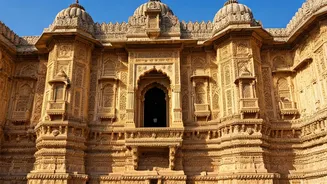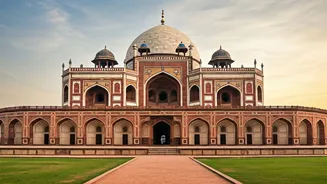Chittorgarh's Fortified History
Chittorgarh, a city in the vibrant state of Rajasthan, showcases the grandeur of a bygone era, primarily through its imposing fort. The fort, a UNESCO
World Heritage site, is not merely a structure; it is a silent narrator of tales of valor, sacrifice, and architectural brilliance. Key structures within the fort, such as the Fateh Prakash Palace and Rana Kumbha Palace, illustrate the refined tastes and strategic foresight of Rajput rulers. Visiting Chittorgarh is more than sightseeing; it’s an immersive experience into the heart of Rajputana, which is filled with bravery, loyalty, and honor. The fort's numerous structures, from the Vijay Stambha (Victory Tower) to the Kirti Stambh (Tower of Fame), provide important insights into the artistic and military prowess that defined the region. Today, Chittorgarh’s fort remains a significant symbol of India’s rich cultural heritage, attracting visitors who seek to explore the past and reflect on the legacies that have shaped the nation's identity.
Fateh Prakash's Splendor
The Fateh Prakash Palace stands as a stunning representation of the Rajput's architectural achievements. This palace, renowned for its intricate design and architectural elegance, offers insights into the lifestyle of the royal family. Built with exquisite craftsmanship, Fateh Prakash Palace is decorated with vibrant colors, detailed carvings, and ornate structures, symbolizing the creative mastery of the era. It is known that the palace contains a museum with a unique collection of sculptures, portraits, and artifacts that reflect the rich cultural heritage of Chittorgarh. The beauty of Fateh Prakash Palace extends beyond its architectural design, offering historical context to understand the region’s artistic and cultural progress. Visiting this palace allows a glimpse into the past and offers a memorable experience that highlights the beauty of Rajasthan's architectural heritage.
Sacred Gaumukh Kund
Gaumukh Kund is a sacred water reservoir inside the fort, serving as a place of significant religious and cultural importance. This natural spring, which is known for its clear water, is believed to be a source of divine energy and purity. As the name suggests, the water flows through a structure that is shaped like a cow's mouth, which is an important feature of the site. The surroundings of Gaumukh Kund offer a peaceful atmosphere, making it a spot for reflection and spiritual retreat. It is known that the pond is surrounded by numerous temples and shrines, representing the deep religious connections within the fort. Visiting Gaumukh Kund not only gives a chance to experience the peace but also helps to understand the religious beliefs of the people of Rajasthan, which shows the blending of nature and spirituality.
Iconic Victory Monuments
The Vijay Stambha (Victory Tower) and Kirti Stambh (Tower of Fame) are significant architectural monuments within Chittorgarh Fort. The Vijay Stambha, standing tall, represents the triumph of Mewar rulers and celebrates their military victories. The tower is decorated with detailed carvings that showcase the history, mythology, and artistic skill of the period. On the other hand, Kirti Stambh, a Jain monument, reflects the religious diversity and architectural style of that era. The tower's design includes intricate carvings and patterns that represent Jain religious figures and concepts. Both monuments are perfect examples of the architectural genius and the cultural diversity of Chittorgarh. These towers have not only historical value but also offer panoramic views of the fort and the surrounding area, which is a perfect viewpoint for any visitor.
Rana Kumbha's Palace
Rana Kumbha Palace is an important historical structure within Chittorgarh Fort, known for its strategic significance and association with the Mewar rulers. The palace's ruins reveal the planning and strength of the building, including its strategic design. Historically, this palace was an important center for royal activities, including meetings, celebrations, and military planning. It is known that the palace's location within the fort provided both security and control, showing the military genius of the rulers. The remains of the palace allow the visitors to imagine the lives of the royals and the events that shaped the history of Chittorgarh. Visiting the Rana Kumbha Palace offers a chance to understand the political and social history of the Mewar dynasty and the central role that the fort played in shaping regional events.



